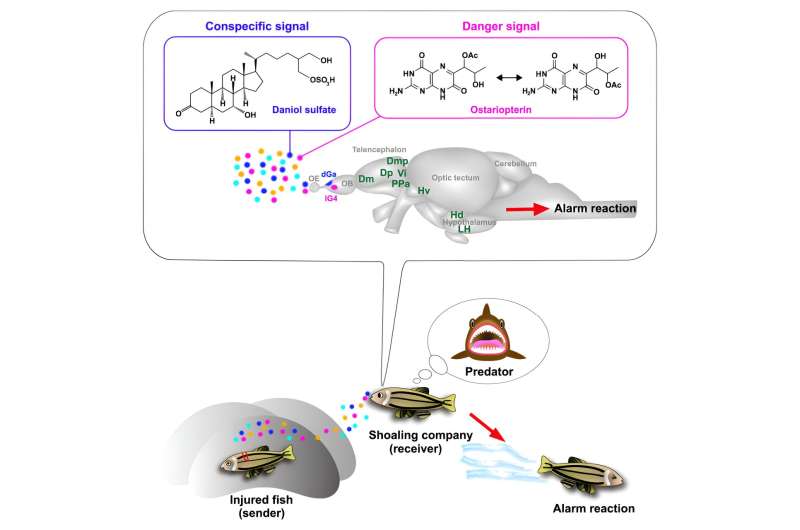This article has been reviewed according to Science X's editorial process and policies. Editors have highlighted the following attributes while ensuring the content's credibility:
fact-checked
peer-reviewed publication
trusted source
proofread
Smelling danger in the water: Schreckstoff mystery solved after 86 years

Researchers led by Yoshihiro Yoshihara at the RIKEN Center for Brain Science in Japan have solved a fishy mystery dating back to 1938: What is the schreckstoff—or alarm substance—that fish smell when their shoal-mates are injured?
In the new study, published in Current Biology, experiments revealed that the substance is actually two substances, each conveying separate pieces of information. Only when both chemical messages are detected will fish react with a flight-or-freeze response. This type of biologically coded coincidence detection likely governs numerous types of social behaviors in animals, including humans.
In 1938, Nobel prize-winner Karl von Frisch discovered that a shoal of minnows behaved as if a predator was nearby when an injured minnow was placed in their tank. This defense mechanism allows fish to avoid danger even when they have not directly detected a predator themselves. von Frisch surmised that some schreckstoff ( "frightening stuff" in German) was released from the injured minnow's skin and was detected by its shoal-mates through their sense of smell, called olfaction.
Since then, scientists have found that fish in the superorder Ostariophysi, which account for about 75% of all fresh-water fish, behave similarly, but only if the injured fish is of the same species. However, despite many years of research, the identity of the alarm substances has remained a mystery until now.
"Many researchers have attempted to purify and identify alarm substances using skin extracts from various species of fish," explains Yoshihara. "What sets our study apart, and the reason for our success, was that we chose a completely different type of screening method."
In previous studies, scientists screened substances for purification by dropping individual chemicals into fish tanks and observing how fish reacted. Then they reported the substances that triggered the greatest fear response. However, the results were not often reliable or repeatable.
In the new study, Yoshihara's team screened for substances based on brain activity. They dropped damaged zebrafish skin into a tank of zebrafish and then used immunohistochemistry to visualize which parts of the fish brain's olfactory bulb reacted.
They next repeated the same experiment using damaged skin from two other types of fish: goldfish, which are in the same Ostariophysi superorder, and medaka, which are not.
They found that three olfactory brain regions reacted to the damaged skin. One was non-specific, responding to all three types of damaged skin, one was superorder-specific, reacting only to goldfish and zebrafish skin, and one was zebrafish-specific. As medaka do not have alarm responses, and zebrafish did not react much to damaged goldfish skin, the researchers reasoned that two chemical signals were necessary for the behavior to occur: a superorder-specific smell signaling "danger!" and a species-specific smell signaling "for us."
Using an advanced system they had previously developed, the researchers biochemically purified the exact molecule responsible for the zebrafish-specific brain response, which they named "Daniol sulfate" because zebrafish are in the genus Danio. Next, using a special type of chromatography in conjunction with calcium imaging of the brain, they identified the molecule that causes the Ostariophysi-specific olfactory response, which they named Ostariopterin.
When they examined the skin of numerous fish species, they found that consistent with their theory, Daniol sulfate was unique to zebrafish, while Ostariopterin was observed in numerous fish species from the Ostariophysi superorder.
To test their theory, the researchers repeated their experiments using these compounds instead of damaged skin. Zebrafish did show the characteristic robust fear response, but as predicted, only when both Daniol sulfate and Ostariopterin were put into the water. Additionally, only in this condition did the researchers observe activity in the zebrafish amygdala, a brain region known to control the fear response itself. Therefore, this region is likely where coincidence detection takes place.
"Conspecific odors can drive numerous behaviors, and even people are known to react to odors produced by other people," says Yoshihara. "This type of biological two-factor messaging system could therefore be a common theme underlying many types of social communication through olfaction."
More information: Miwa Masuda et al, Identification of olfactory alarm substances in zebrafish, Current Biology (2024). DOI: 10.1016/j.cub.2024.02.003
Journal information: Current Biology
Provided by RIKEN
















